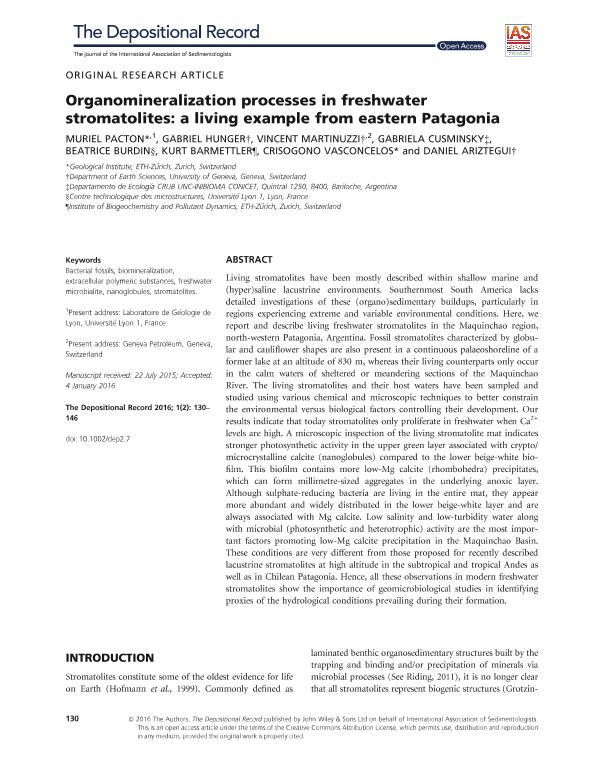Artículo
Organomineralization processes in freshwater stromatolites: a living example from eastern Patagonia
Pacton, Muriel; Hunger, Gabriel; Martinuzzi, Vincent; Cusminsky, Gabriela Catalina ; Burdin, Beatrice; Barmettler, Kurt; Vasconcelos, Crisogono; Ariztegui, Daniel
; Burdin, Beatrice; Barmettler, Kurt; Vasconcelos, Crisogono; Ariztegui, Daniel
 ; Burdin, Beatrice; Barmettler, Kurt; Vasconcelos, Crisogono; Ariztegui, Daniel
; Burdin, Beatrice; Barmettler, Kurt; Vasconcelos, Crisogono; Ariztegui, Daniel
Fecha de publicación:
12/2015
Editorial:
interntional Association of Sedimentology Wiley on line Library
Revista:
The Depositional Record
ISSN:
2055-4877
Idioma:
Inglés
Tipo de recurso:
Artículo publicado
Clasificación temática:
Resumen
Living stromatolites have been mostly described within shallow marine and (hyper)saline lacustrine environments. Southernmost South America lacks detailed investigations of these (organo)sedimentary buildups, particularly in regions experiencing extreme and variable environmental conditions. Here, we report and describe living freshwater stromatolites in the Maquinchao region, north‐western Patagonia, Argentina. Fossil stromatolites characterized by globular and cauliflower shapes are also present in a continuous palaeoshoreline of a former lake at an altitude of 830 m, whereas their living counterparts only occur in the calm waters of sheltered or meandering sections of the Maquinchao River. The living stromatolites and their host waters have been sampled and studied using various chemical and microscopic techniques to better constrain the environmental versus biological factors controlling their development. Our results indicate that today stromatolites only proliferate in freshwater when Ca2+ levels are high. A microscopic inspection of the living stromatolite mat indicates stronger photosynthetic activity in the upper green layer associated with crypto/microcrystalline calcite (nanoglobules) compared to the lower beige‐white biofilm. This biofilm contains more low‐Mg calcite (rhombohedra) precipitates, which can form millimetre‐sized aggregates in the underlying anoxic layer. Although sulphate‐reducing bacteria are living in the entire mat, they appear more abundant and widely distributed in the lower beige‐white layer and are always associated with Mg calcite. Low salinity and low‐turbidity water along with microbial (photosynthetic and heterotrophic) activity are the most important factors promoting low‐Mg calcite precipitation in the Maquinchao Basin. These conditions are very different from those proposed for recently described lacustrine stromatolites at high altitude in the subtropical and tropical Andes as well as in Chilean Patagonia. Hence, all these observations in modern freshwater stromatolites show the importance of geomicrobiological studies in identifying proxies of the hydrological conditions prevailing during their formation.
Archivos asociados
Licencia
Identificadores
Colecciones
Articulos(INIBIOMA)
Articulos de INST. DE INVEST.EN BIODIVERSIDAD Y MEDIOAMBIENTE
Articulos de INST. DE INVEST.EN BIODIVERSIDAD Y MEDIOAMBIENTE
Citación
Pacton, Muriel; Hunger, Gabriel; Martinuzzi, Vincent; Cusminsky, Gabriela Catalina; Burdin, Beatrice; et al.; Organomineralization processes in freshwater stromatolites: a living example from eastern Patagonia; interntional Association of Sedimentology Wiley on line Library; The Depositional Record; 1; 2; 12-2015; 130-146
Compartir
Altmétricas



